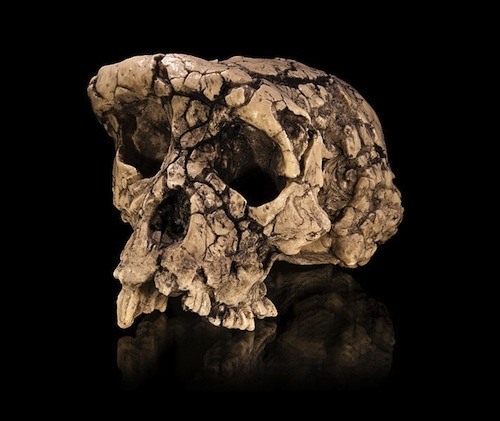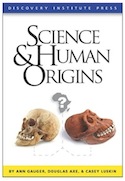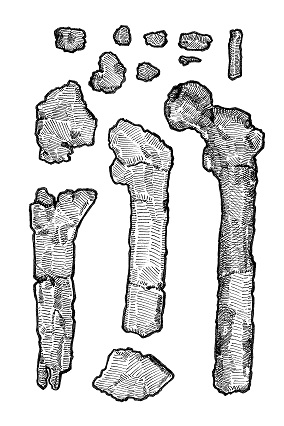 Evolution
Evolution
 Human Origins
Human Origins
The Fragmented Fossil Record of Early Hominins

 Human Origins and the Fossil Record: A Recap Human Origins and the Fossil Record: A Recap— Read the Book: Science and Human Origins — • Part 1: Human Origins and the Fossil Record: What Does the Evidence Say? |
Despite much hype in the media, the earliest hominin fossils are often so fragmentary that they remain the subject of considerable controversy in the scientific community. Let’s examine some of the main early hominin fossils and the debates surrounding them.
Sahelanthropus tchadensis: “Toumai Skull”
Notwithstanding that Sahelanthropus tchadensis (also called the “Toumai skull”) is known only from one skull and some jaw fragments, it has been called the oldest known hominin that lies directly on the human line.

But not everyone agrees. When the fossil was first reported, Brigitte Senut, a leading researcher at the Natural History Museum in Paris, said “I tend towards thinking this is the skull of a female gorilla.”22 Writing in Nature with Milford H. Wolpoff, Martin Pickford, and John Hawks, Senut later noted there are “many… features that link the specimen with chimpanzees, gorillas or both, to the exclusion of hominids,” and argued “Sahelanthropus does not appear to have been an obligate biped.”23 In their view, “Sahelanthropus was an ape.”24
This debate has continued, but leading paleoanthropologists have cautioned in the Proceedings of the National Academy of Sciences (USA) that teeth and skull fragments alone are insufficient to properly classify or understand species as a hominin: “[O]ur results show that the type of craniodental characters that have hitherto been used in hominin phylogenetics are probably not reliable for reconstructing the phylogenetic relationships of higher primate species and genera, including those among the hominins.”25
At one point during the 2009 Texas evolution hearings, anthropology professor Ronald Wetherington testified that “every fossil we find reinforces the sequence that we had previously supposed to exist rather than suggesting something different.”26 But this fossil, first reported in 2002, provides a striking counterexample to that assertion.
Commenting on the Toumai skull in the journal Nature, Bernard Wood of George Washington University opened by observing, “A single fossil can fundamentally change the way we reconstruct the tree of life.”27 He went on to state:
If we accept these as sufficient evidence to classify S. tchadensis as a hominid at the base, or stem, of the modern human clade, then it plays havoc with the tidy model of human origins. Quite simply, a hominid of this age should only just be beginning to show signs of being a hominid. It certainly should not have the face of a hominid less than one-third of its geological age. Also, if it is accepted as a stem hominid, under the tidy model the principle of parsimony dictates that all creatures with more primitive faces (and that is a very long list) would, perforce, have to be excluded from the ancestry of modern humans.28
In other words, if the Toumai skull is accepted as a stem ancestor of humans, then many later supposed human ancestors — including the acclaimed australopithecines — ought not be considered human ancestors. Wood concludes that fossils like Sahelanthropus show “compelling evidence that our own origins are as complex and as difficult to trace as those of any other group of organisms.”29
Orrorin tugensis: “Orrorin”
Orrorin, which means “original man” in a local Kenyan language, was a chimpanzee-sized primate known only from “an assortment of bone fragments,”30 including pieces of the arm, thigh, and lower jaw, as well as some teeth. When the fossil was initially discovered, the New York Times ran a story titled “Fossils May Be Earliest Human Link,”31 and reported it “may be the earliest known ancestor of the human family.”32 Despite the meagerness of the find, enough enthusiasm was stirred that an article in Nature soon after the fossil’s unveiling cautioned that “excitement needs to be tempered with caution in assessing the claim of a six-million-year-old direct ancestor of modern humans.”33

Figure: Fragments of Orrorin tugensis.
Illustration: Jonathan Jones.
Some paleoanthropologists claimed that Orrorin’s femur indicates a bipedal mode of locomotion that was “appropriate for a population standing at the dawn of the human lineage.”34 But as a later Yale University Press commentary admitted, “All in all, there is currently precious little evidence bearing on how Orrorin moved.”35
Evolutionary paleoanthropologists often assume that bipedality is a litmus test for membership along the human line. So if Orrorin did prove to be an upright-walking ape-like creature from six million years ago (mya), would that qualify it as a human ancestor? Not at all. In fact, the fossil record contains bipedal apes that evolutionists recognize were far removed from the human line. In 1999, UC San Diego biologist Christopher Wills observed that “[u]pright posture may not be unique to our own lineage” since “[a]n ape that lived ten million years ago on Sardinia, Oreopithecus bambolii, seems to have acquired similar capabilities, perhaps independently.”36 A more recent article in Science Daily elaborated:
Oreopithecus bambolii, a fossil ape from Italy shares many similarities with early human ancestors, including features of the skeleton that suggest that it may have been well adapted for walking on two legs. However, the authors observe, enough is known of its anatomy to show that it is a fossil ape that is only distantly related to humans, and that it acquired many “human-like” features in parallel.37
A 2011 paper in Nature by Bernard Wood and Terry Harrison explains the implications of bipedal apes that had nothing to do with human origins:
The object lesson that Oreopithecus provides is critical to the debate about interpreting the relationships of the earliest purported hominins. It demonstrates how features considered to be hominin specializations can be shown to have been acquired independently in a non-hominin lineage in association with inferred behaviors that are functionally related to, but not necessarily narrowly restricted to, terrestrial bipedalism.38
Much as the Toumai skull threatened to displace australopithecines from our ancestral line, Pickford and his co-authors argued that if their hypothesis about Orrorin is correct, then australopithecines are again no longer ancestral to humans, but were merely “a side branch of hominid evolution that went extinct.”39 This hypothesis was not well received by many paleoanthropologists, because they need the australopithecines to serve as an evolutionary precursor leading to our genus Homo. Another paper in Nature showed how dissenting views are treated in paleoanthropology, charging that Pickford’s “simple phylogeny contrasts starkly with mainstream ideas about human evolution, and glosses over many areas of controversy and uncertainty.”40
While Orrorin offers evolutionary paleoanthropologists the tantalizing possibility of a bipedal creature that lived around the time of the supposed split between humans and chimpanzees, simply too little of it is known at present to make confident claims about its locomotion, or its proper place in the supposed evolutionary tree.
Ardipithecus ramidus: “Ardi”
In 2009, the journal Science announced the publication of long-awaited reports about a 4.4 mya fossil named Ardipithecus ramidus. Expectations were high as its discoverer, UC Berkeley paleoanthropologist Tim White, had previously promised the fossil was a “phenomenal individual” that would be the “Rosetta stone for understanding bipedalism.”41 When the papers were finally released, the science media took it as an opportunity to evangelize the public for Darwin via the fossil they affectionately dubbed “Ardi.”
The Discovery Channel ran the headline “‘Ardi,’ Oldest Human Ancestor, Unveiled,” and quoted White who stated that Ardi is “as close as we have ever come to finding the last common ancestor of chimpanzees and humans.”42 The Associated Press headline read “World’s oldest humanlinked skeleton found,” with the article claiming “the new find provides evidence that chimps and humans evolved from some long-ago common ancestor.”43
The journal Science named Ardi the “breakthough of the year” for 2009,44 and officially introduced her with an article titled “A New Kind of Ancestor: Ardipithecus Unveiled.”45
Calling this fossil “new” was not quite accurate, since Ardi was discovered in the early 1990s. Why did it take over 15 years for reports to be published? A 2002 article in Science explains that initially the bones were so “soft,” “crushed,” “squished,” and “chalky,” that White reported, “when I clean an edge it erodes, so I have to mold every one of the broken pieces to reconstruct it.”46 Later reports similarly acknowledged that “some portions of Ardi’s skeleton were found crushed nearly to smithereens and needed extensive digital reconstruction,” and that its pelvis initially “looked like an Irish stew.”47
The 2009 report in Science tells a striking story of the fossil’s poor quality: “[T]he team’s excitement was tempered by the skeleton’s terrible condition. The bones literally crumbled when touched. White called it road kill. And parts of the skeleton had been trampled and scattered into more than 100 fragments; the skull was crushed to 4 centimeters in height.”48 In an article titled “Oldest Skeleton of Human Ancestor Found,” the science editor at National Geographic put it this way: “After Ardi died, her remains apparently were trampled down into mud by hippos and other passing herbivores. Millions of years later, erosion brought the badly crushed and distorted bones back to the surface. They were so fragile they would turn to dust at a touch.”49
Claims about bipedal locomotion in hominids require careful and accurate measurements of the precise shape of various bones. How far should one trust claims about Ardi as a “Rosetta stone for understanding bipedalism” when the bones were initially “crushed to smithereens” and “would turn to dust at a touch”? Several skeptical paleoanthropologists felt those claims warranted little credence. As Science reported:
[S]everal researchers aren’t so sure about these inferences. Some are skeptical that the crushed pelvis really shows the anatomical details needed to demonstrate bipedality. The pelvis is “suggestive” of bipedality but not conclusive, says paleoanthropologist Carol Ward of the University of Missouri, Columbia. Also, Ar. ramidus “does not appear to have had its knee placed over the ankle, which means that when walking bipedally, it would have had to shift its weight to the side,” she says. Paleoanthropologist William Jungers of Stony Brook University in New York State is also not sure that the skeleton was bipedal. “Believe me, it’s a unique form of bipedalism,” he says. “The postcranium alone would not unequivocally signal hominin status, in my opinion.”50
A subsequent paper by primatologist Esteban Sarmiento in Science noted that “All of the Ar. ramidus bipedal characters cited also serve the mechanical requisites of quadrupedality, and in the case of Ar. Ramidus foot-segment proportions, find their closest functional analog to those of gorillas, a terrestrial or semiterrestrial quadruped and not a facultative or habitual biped.”51
Critics also questioned the claim that Ardi was necessarily ancestral to humans. When Ardi’s reports were first published, Bernard Wood stated, “I think the head is consistent with it being a hominin… but the rest of the body is much more questionable.”52 Two years later, Wood co-wrote a paper in Nature elaborating on those criticisms, observing that if “Ardipithecus is assumed to be a hominin,” and ancestral to humans, then this implies the fossil had “remarkably high levels of homoplasy among extant great apes.”53 In other words, Ardi had many ape-like characteristics which, if we set aside the preferences of many evolutionary paleoanthropologists, might imply a much closer relationship to living apes than to humans. According to a Science Daily article reporting on Wood’s Nature paper, the claim of Ardi “being a human ancestor is by no means the simplest, or most parsimonious explanation.”54 Stanford University anthropologist Richard Klein put it this way: “I frankly don’t think Ardi was a hominid, or bipedal.”55
Sarmiento observed that Ardi had characteristics that are different not just from humans, but also from apes. In a Time Magazine interview, “Ardi: The Human Ancestor Who Wasn’t?,” he elaborated:
“[Tim White] showed no evidence that Ardi is on the human lineage,” Sarmiento says. “Those characters that he posited as relating exclusively to humans also exist in apes and ape fossils that we consider not to be in the human lineage.”
The biggest mistake White made, according to the paper, was to use outdated characters and concepts to classify Ardi and to fail to identify anatomical clues that would rule her out as a human ancestor. As an example, Sarmiento says that on the base of Ardi’s skull, the inside of the jaw joint surface is open as it is in orangutans and gibbons, and not fused to the rest of the skull as it is in humans and African apes — suggesting that Ardi diverged before this character developed in the common ancestor of humans and apes.56
Whatever Ardi may have been, everyone agrees that this fossil was initially badly crushed and needed extensive reconstruction. Its discoverers adamantly maintain the specimen was a bipedal human ancestor, or something very close to it. No doubt this debate will continue, but are we obligated to take for granted the bold talking points promoted by Ardi’s discoverers in the media? Sarmiento doesn’t think so. According to Time Magazine, he “regards the hype around Ardi to have been overblown.”57
[Editor’s Note: This is an excerpt from Chapter 3, “Human Origins and the Fossil Record,” of the new book Science and Human Origins, co-authored by Ann Gauger, Douglas Axe, and Casey Luskin. For details, see Discovery Institute Press.]
References Cited:
[22.] “Skull find sparks controversy,” BBC News (July 12, 2002), accessed March 4, 2012, “One of Dr Senut’s colleagues, Dr. Martin Pickford, who was in London this week, is also reported to have told peers that he thought the new Chadian skull was from a ‘proto-gorilla.'”
[23.] Milford H. Wolpoff, Brigitte Senut, Martin Pickford, and John Hawks, “Sahelanthropus or ‘Sahelpithecus’?,” Nature, 419 (October 10, 2002): 581-82.
[24.] Ibid.
[25.] Mark Collard and Bernard Wood, “How reliable are human phylogenetic hypotheses?,” Proceedings of the National Academy of Sciences (USA) , 97 (April 25, 2000): 5003-06.
[26.] Ronald Wetherington testimony before Texas State Board of Education (January 21, 2009). Time Index 2:06:00-2:06:08.
[27.] Bernard Wood, “Hominid revelations from Chad,” Nature, 418 (July 11, 2002):133-35.
[28.] Ibid.
[29.] Bernard Wood, “Hominid revelations from Chad,” Nature, 418 (July 11, 2002):133-35.
[30.] Potts and Sloan, What Does it Mean to be Human?, 38.
[31.] John Noble Wilford, “Fossils May Be Earliest Human Link,” New York Times (July 12, 2001), accessed March 4, 2012, http://www.nytimes.com/2001/07/12/world/fossils-may-be-earliest-human-link.html.
[32.] John Noble Wilford, “On the Trail of a Few More Ancestors,” New York Times (April 8, 2001), accessed March 4, 2012, http://www.nytimes.com/2001/04/08/world/on-the-trail-of-a-few-more-ancestors.html.
[33.] Leslie C. Aiello and Mark Collard, “Our newest oldest ancestor?,” Nature, 410 (March 29, 2001): 526-27.
[34.] K. Galik, B. Senut, M. Pickford, D. Gommery, J. Treil, A. J. Kuperavage, and R. B. Eckhardt, “External and Internal Morphology of the BAR 1002’00 Orrorin tugenensis Femur,” Science, 305 (September 3, 2004): 1450-53.
[35.] Sarmiento, Sawyer, and Milner, The Last Human: A Guide to Twenty-two Species of Extinct Humans, 35.
[36.] Christopher Wills, Children of Prometheus: The Accelerating Pace of Human Evolution (New York: Basic Books, 1999), 156.
[37.] “Fossils May Look Like Human Bones: Biological Anthropologists Question Claims for Human Ancestry,” Science Daily (February 16, 2011), accessed March 4, 2012, http://www.sciencedaily.com/releases/2011/02/110216132034.htm.
[38.] Bernard Wood and Terry Harrison, “The evolutionary context of the first hominins,” Nature, 470 (February 17, 2011): 347-52.
[39.] Martin Pickford, “Fast Breaking Comments,” Essential Science Indicators Special Topics (December 2001), accessed March 4, 2012, http://www.esi-topics.com/fbp/comments/december-01-Martin-Pickford.html.
[40.] Aiello and Collard, “Our newest oldest ancestor?,” 526-27.
[41.] Tim White, quoted in Ann Gibbons, “In Search of the First Hominids,” Science, 295 (February 15, 2002): 1214-19.
[42.] Jennifer Viegas, “‘Ardi,’ Oldest Human Ancestor, Unveiled,” Discovery News (October 1, 2009), accessed March 4, 2012, http://news.discovery.com/history/ardi-human-ancestor.html.
[43.] Randolph E. Schmid, “World’s oldest human-linked skeleton found,” MSNBC (October 1, 2009), accessed March 4, 2012, http://www.msnbc.msn.
com/id/33110809/ns/technology_and_science-science/t/worlds-oldest-human-linked-skeleton-found/.
[44.] Ann Gibbons, “Breakthrough of the Year: Ardipithecus ramidus,” Science, 326 (December 18, 2009): 1598-99.
[45.] Ann Gibbons, “A New Kind of Ancestor: Ardipithecus Unveiled,” 36-40.
[46.] Gibbons, “In Search of the First Hominids,” 1214-19.
[47.] Michael D. Lemonick and Andrea Dorfman, “Ardi Is a New Piece for the Evolution Puzzle,” Time (October 1, 2009), accessed March 4, 2012, http://www.time.com/time/printout/0,8816,1927289,00.html.
[48.] Gibbons, “A New Kind of Ancestor: Ardipithecus Unveiled,” 36-40. See also Gibbons, The First Human: The Race to Discover our Earliest Ancestors, 15 (“The excitement was tempered, however, by the condition of the skeleton. The bone was so soft and crushed that White later described it as road-kill”).
[49.] Jamie Shreeve, “Oldest Skeleton of Human Ancestor Found,” National Geographic (October 1, 2009), accessed March 4, 2012, http://news.nationalgeographic.com/news/2009/10/091001-oldest-human-skeleton-ardi-missinglink-chimps-ardipithecus-ramidus.html.
[50.] Gibbons, “A New Kind of Ancestor: Ardipithecus Unveiled,” 36-40.
[51.] Esteban E. Sarmiento, “Comment on the Paleobiology and Classification of Ardipithecus ramidus,” Science, 328 (May 28, 2010): 1105b.
[52.] Gibbons, “A New Kind of Ancestor: Ardipithecus Unveiled,” 36-40.
[53.] Wood and Harrison, “The evolutionary context of the first hominins,” 347-52.
[54.] “Fossils May Look Like Human Bones: Biological Anthropologists Question Claims for Human Ancestry.”
[55.] John Noble Wilford, “Scientists Challenge ‘Breakthrough’ on Fossil Skeleton,” New York Times (May 27, 2010), accessed March 4, 2012, http://www.nytimes.com/2010/05/28/science/28fossil.html.
[56.] Eben Harrell, “Ardi: The Human Ancestor Who Wasn’t?,” Time (May 27, 2010), at http://www.time.com/time/health/article/0,8599,1992115,00.html.
[57.] Ibid.
Image: Sahelanthropus tchadensis, Toumai skull; Wikipedia.
